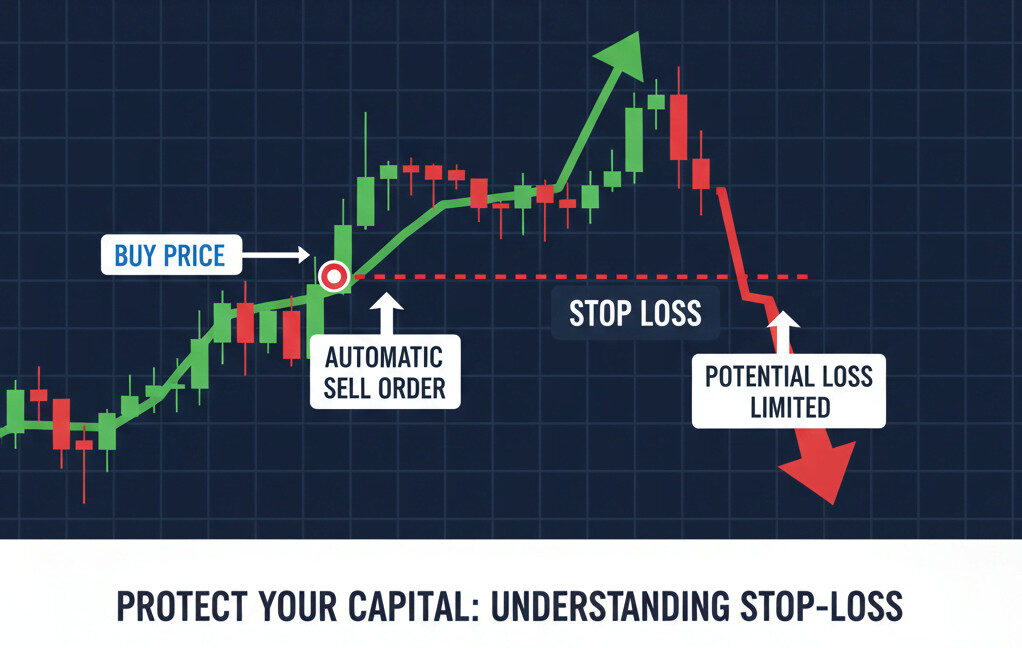Getting started with intraday trading can be both exciting and overwhelming. Many new traders dive into the markets without proper preparation, leading to costly mistakes. If you are searching for effective intraday trading tips, this guide will help you understand the basics, avoid common pitfalls, and build a disciplined approach.
Table of Contents
What is Intraday Trading?
I belive you are beginner for trading so before going further let me quickly let you know what is Intraday trading or also called day trading?
It refers to buying and selling stocks within the same trading day. Unlike investing, which focuses on long-term growth, intraday trading aims to capture short-term price movements. For beginners in India, learning how to do intraday trading requires understanding of stock market dynamics, timing, and risk management.

10 Simple Intraday Trading Tips for Beginners in India
1. Start with Liquid Stocks
Choose best stocks (usually Nifty50 stocks) for intraday trading that are highly liquid. Large-cap stocks and stocks from Nifty or Sensex usually provide sufficient volume, making entry and exit easier. Stocks with less liquidity may trap you due to low buyers and sellers.
Less liquidity stocks can be easily manipulated by large institutional players, so as a beginner it is highly risky and also not recommended to do trading in such stocks with low liquidity.
2. Define Entry and Exit Levels
One of the most important intraday trading rules for beginners is to set a clear entry point and exit target before entering a trade. This prevents emotional decision-making and keeps you disciplined thought your trading journey. If you trade with the emotion of making more money the trade may go against your planning and you may face losses.
3. Always Use a Stop-Loss
Stop-loss is your safety net. Beginners often overlook this, but it helps you limit losses when trades goes against you. Following this is very important to avoid common intraday trading mistakes.

Now let us consider you have ignored or you have not set any stop-loss in your trade, If the market goes against your trade then you may loose your hole capital (invested money). In the other way if you had set a stop-loss as name suggest it will limit your loss so that there will me no risking of loosing the entire capital.
4. Avoid Overtrading
Many new traders assume that more trades mean more profit. In reality, overtrading increases brokerage costs and risks. Stick to 2 or at most 3 quality trades backed by good analysis is sufficient for to be a profitable trader.
The very big mistake that a beginner trader make is trying to recover losses and also over trading. When you trade to recover the losses people usually think of profit, profit, profit but they don’t go for the research or analysis in return resulting in more losses insted of recovering. So donot over trade at any cost.
5. Follow Market Trends
Successful traders align their trades with the market trend. As a part of basic intraday trading strategies, buy when the market shows upward momentum and sell when the trend is bearish.
6. Focus on a Few Stocks Only
Instead of tracking the entire market, select 4–5 good stocks with high liquidity and master their price movements. This helps you make simple intraday strategies without being overwhelmed.
7. Avoid Trading in the First 30 Minutes
The opening minutes of the market are often volatile. Beginners should wait for the trend to stabilize before entering any trades. This is a golden intraday trading tip for new traders.
Since the market is usually volatile in first 30 minutes of the trading session there may be the high chances of trend change, hitting of stop-loss etc resulting in facing losses.
8. Have a Risk-Reward Ratio
A good intraday trading guide for beginners always emphasizes maintaining at least a 1:2 risk-reward ratio. For example, if you risk loosing ₹100, aim for at least ₹200 profit. In other way we can also so that if you set your stop-loss to -100/- then your target for the trade must be +200/-
Example
Let me explain this with a simple example, I bought 100 shares of KTKBANK with an average of 75/- so my capital will be 7,500/-. Let me say that I am capable of bearing 500/- loss if my trade goes against me then I will set my stop-loss to 70/-. According to my 1:2 risk to reward ration my target must be set to 85/- so that I can exit my trade with 1000/- rupees profit.
NOTE:- I have used KTKBANK stock for just explaining the concept. This is not a stock recommendation make your own research and contact your financial advisor before investing.
9. Keep Emotions Under Control
Greed and fear are your worst enemies. Many traders ask how to make a profit in intraday trading, and the answer often lies in emotional discipline. Stick to your strategy, not your feelings.
10. Learn and Evolve Daily
The Indian stock market is dynamic. Keep updating your knowledge with new intraday trading strategies, follow financial news (I would prefer moneycontrol for financial news), and practice through virtual trading platforms before risking real capital.
Intraday Trading Dos and Don’ts
| Dos | Don’ts |
|---|---|
| Do thorough research before placing trades. | Don’t chase rumors or tips from unverified sources. |
| Use technical indicators like moving averages and RSI. | Don’t hold intraday positions overnight. |
| Keep your trading capital separate from savings. | Don’t risk more than 2% of total capital in one trade. |
Common Intraday Trading Mistakes to Avoid
- Entering without a clear plan.
- Trading in illiquid stocks.
- Ignoring stop-loss orders.
- Averaging losses (buying more in falling stocks).
My Final Thoughts
For anyone starting intraday trading in Indian stock market, the road to success lies in discipline, patience, and continuous learning. Apply these best intraday trading tips consistently and avoid shortcuts. Remember, intraday trading is not about making quick money—it’s about building a sustainable trading approach that rewards you over time.
Frequently Asked Questions By A Beginner Intraday Traders.
Q1. What is the best time for intraday trading in India?
The best time is usually between 10:00 AM to 1:30 PM. The first 30 minutes are very volatile, and the last 30 minutes can see sudden swings. Mid-session offers more stable opportunities.
Q2. Which are the best stocks for intraday trading in India?
Highly liquid and volatile stocks from Nifty 50 or Sensex, such as banking and IT sector stocks, are preferred. Always choose stocks with good trading volumes and price fluctuations.
Q3. Is intraday trading profitable for beginners?
Yes, but only if done with discipline, risk management, and proper strategies. Beginners should start small, avoid overtrading, and focus on learning rather than only profits.
Q4. What are the most common intraday trading mistakes beginners make?
Some frequent mistakes include not setting stop-loss, trading based on rumors, overtrading, and holding intraday positions overnight.
Q5. How to make a profit in intraday trading consistently?
Follow simple intraday strategies like trend following, maintain a risk-reward ratio, and apply strict stop-loss. Avoid emotional decisions and stick to planned strategies.
Q6. What are some basic intraday trading strategies for beginners?
New traders can use strategies like momentum trading, moving average crossover, breakout trading, or range-bound trading. Keep it simple and practice with small trades.
Q7. Can beginners do intraday trading with less capital?
Yes, many brokers in India provide margin facilities, allowing you to trade with lower capital. However, beginners should use margin cautiously to avoid amplified losses.
Q8. How do I start intraday trading in India?
Open a Demat and trading account, choose a reliable broker (I would prefer Zerodha), learn stock market basics, and practice intraday trading strategies in a demo account before investing real money.
Disclaimer: This article is for informational purposes only and does not constitute investment advice. Please consult a financial advisor before making any investment decisions.










